Python: Check whether a distinct pair of numbers whose product is odd present in a sequence of integer values
Python Basic: Exercise-150 with Solution
Write a Python function to check whether a distinct pair of numbers whose product is odd present in a sequence of integer values.
Sample Solution:
Python Code :
def odd_product(nums):
for i in range(len(nums)):
for j in range(len(nums)):
if i != j:
product = nums[i] * nums[j]
if product & 1:
return True
return False
dt1 = [2, 4, 6, 8]
dt2 = [1, 6, 4, 7, 8]
dt3 = [1, 3, 5, 7, 9]
print(dt1, odd_product(dt1));
print(dt2, odd_product(dt2));
print(dt3, odd_product(dt3));
Sample Output:
[2, 4, 6, 8] False [1, 6, 4, 7, 8] True [1, 3, 5, 7, 9] True
Pictorial Presentation of the sequence [2, 4, 6, 8]:
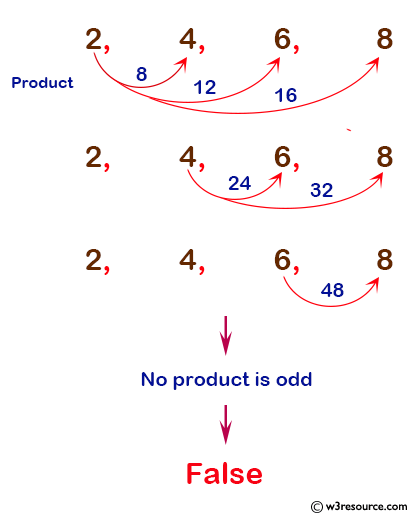
Pictorial Presentation of the sequence [1, 6, 4, 7, 8]:
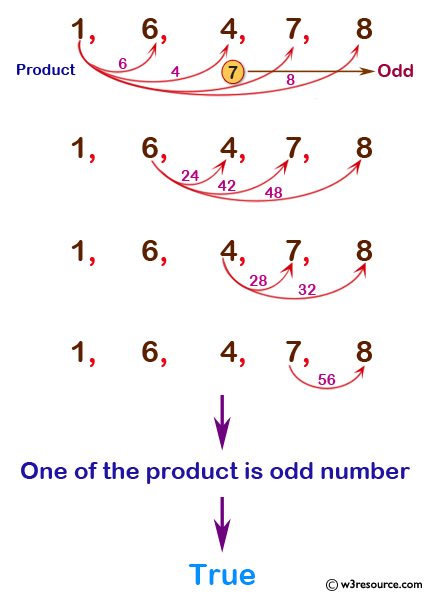
Flowchart:
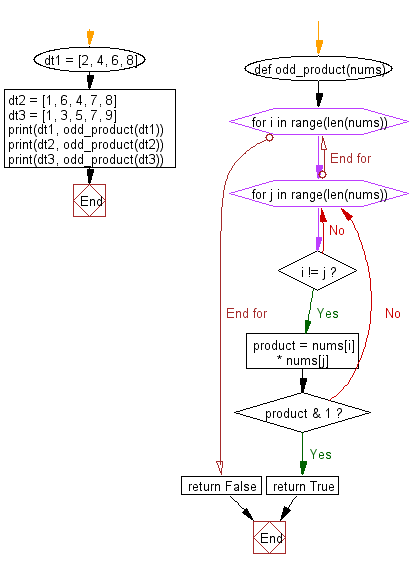
Visualize Python code execution:
The following tool visualize what the computer is doing step-by-step as it executes the said program:
Sample Solution:
Distinct pair of numbers whose product is odd present in a given sequence:
Python Code :
import itertools
def pair_nums_odd(nums):
uniquelist = set(nums)
result =[]
for n in itertools.combinations(uniquelist, 2):
if ((n[0] * n[1]) % 2 == 1):
temp = str(n[0]) + " * " + str(n[1])
result.append(temp)
return result
dt1 = [2, 4, 6, 8]
print("Original sequence:")
print(dt1)
print("Distinct pair of numbers whose product is odd present in the said sequence:")
print(pair_nums_odd(dt1));
dt2 = [1, 6, 4, 7, 8]
print("\nOriginal sequence:")
print(dt2)
print("Distinct pair of numbers whose product is odd present in the said sequence:")
print(pair_nums_odd(dt2));
dt3 = [1, 3, 5, 7, 9]
print("\nOriginal sequence:")
print(dt3)
print("Distinct pair of numbers whose product is odd present in the said sequence:")
print(pair_nums_odd(dt3));
Sample Output:
Original sequence: [2, 4, 6, 8] Distinct pair of numbers whose product is odd present in the said sequence: [] Original sequence: [1, 6, 4, 7, 8] Distinct pair of numbers whose product is odd present in the said sequence: ['1 * 7'] Original sequence: [1, 3, 5, 7, 9] Distinct pair of numbers whose product is odd present in the said sequence: ['1 * 3', '1 * 5', '1 * 7', '1 * 9', '3 * 5', '3 * 7', '3 * 9', '5 * 7', '5 * 9', '7 * 9']
Pictorial Presentation of the sequence [1, 3, 5, 7, 9]:
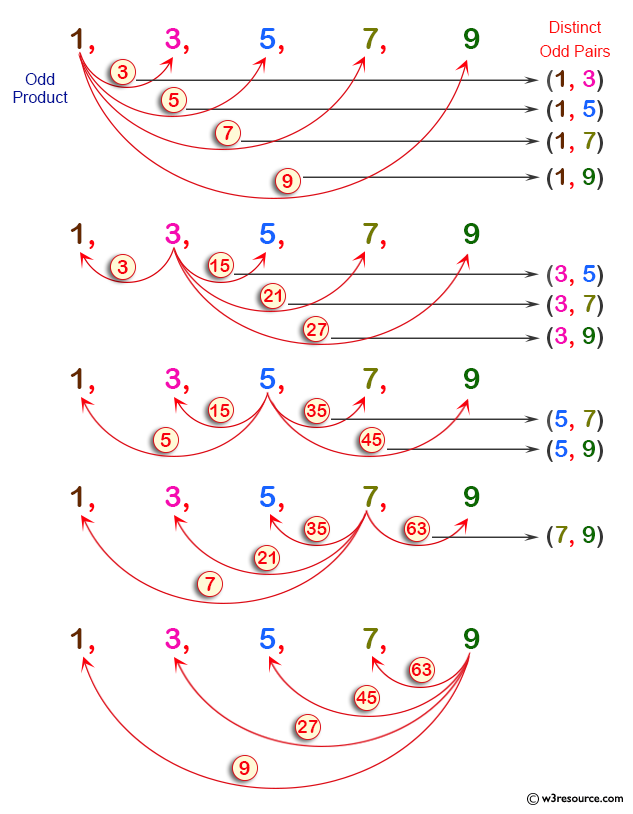
Flowchart:
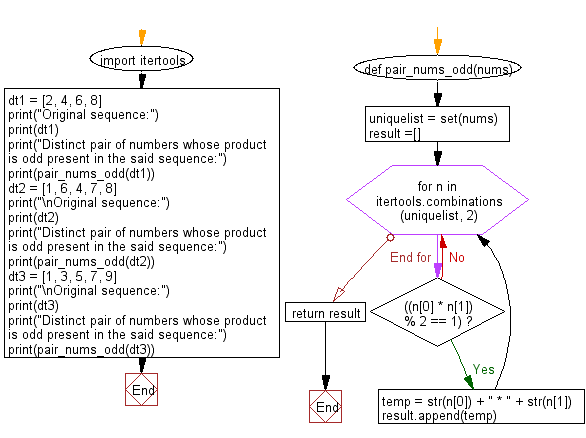
Visualize Python code execution:
The following tool visualize what the computer is doing step-by-step as it executes the said program:
Python Code Editor :
Have another way to solve this solution? Contribute your code (and comments) through Disqus.
Previous: Write a Python function that takes a positive integer and returns the sum of the cube of all the positive integers smaller than the specified number.
Next: Basic - Part-II.
What is the difficulty level of this exercise?
Test your Programming skills with w3resource's quiz.
Python: Tips of the Day
Find current directory and file's directory:
To get the full path to the directory a Python file is contained in, write this in that file:
import os dir_path = os.path.dirname(os.path.realpath(__file__))
(Note that the incantation above won't work if you've already used os.chdir() to change your current working directory, since the value of the __file__ constant is relative to the current working directory and is not changed by an os.chdir() call.)
To get the current working directory use
import os cwd = os.getcwd()
Documentation references for the modules, constants and functions used above:
- The os and os.path modules.
- The __file__ constant
- os.path.realpath(path) (returns "the canonical path of the specified filename, eliminating any symbolic links encountered in the path")
- os.path.dirname(path) (returns "the directory name of pathname path")
- os.getcwd() (returns "a string representing the current working directory")
- os.chdir(path) ("change the current working directory to path")
Ref: https://bit.ly/3fy0R6m
- New Content published on w3resource:
- HTML-CSS Practical: Exercises, Practice, Solution
- Java Regular Expression: Exercises, Practice, Solution
- Scala Programming Exercises, Practice, Solution
- Python Itertools exercises
- Python Numpy exercises
- Python GeoPy Package exercises
- Python Pandas exercises
- Python nltk exercises
- Python BeautifulSoup exercises
- Form Template
- Composer - PHP Package Manager
- PHPUnit - PHP Testing
- Laravel - PHP Framework
- Angular - JavaScript Framework
- Vue - JavaScript Framework
- Jest - JavaScript Testing Framework
